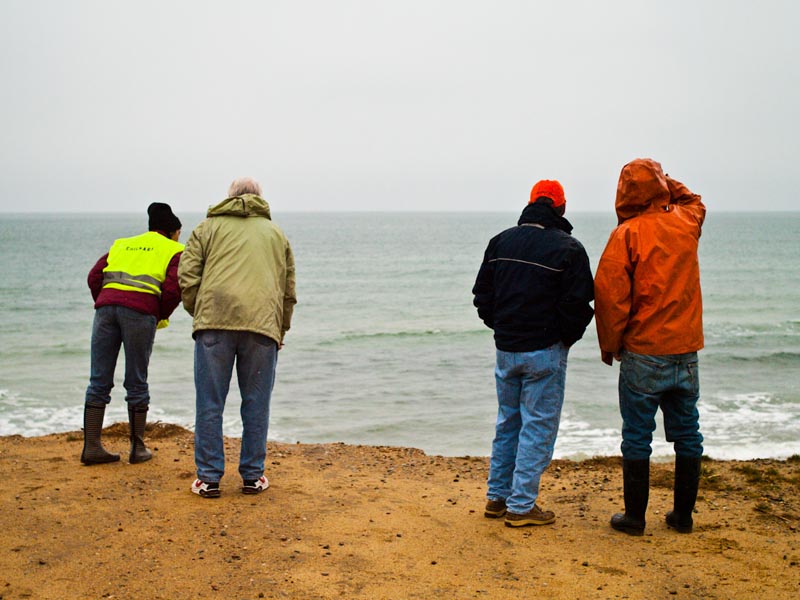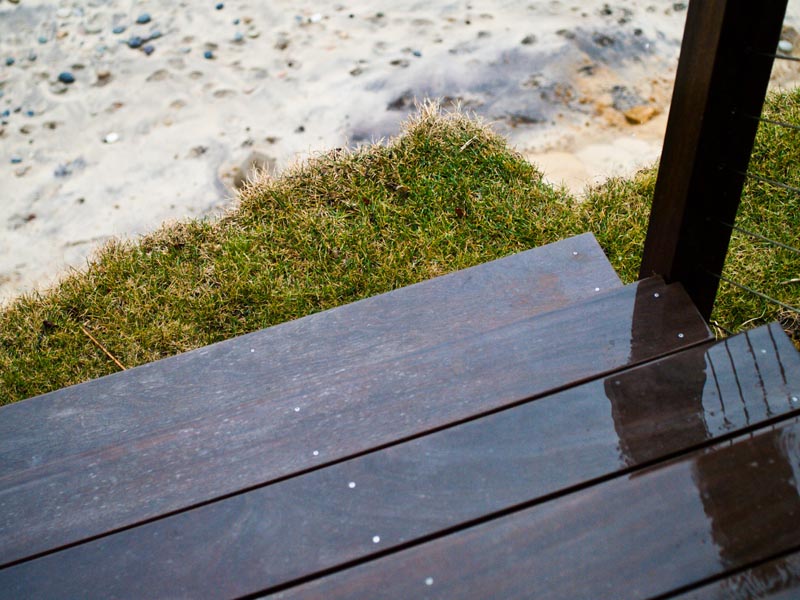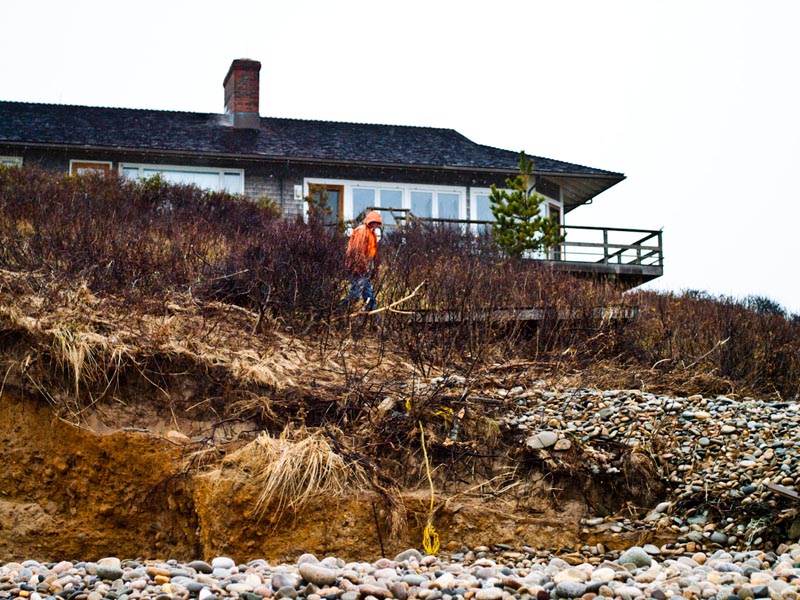Following Hurricane Sandy’s blow to the south-facing coastline of the Vineyard last month, the Chilmark conservation commission is now facing a slew of plans for beach protection, including a request to move two homes and a shed now perilously perched atop the cliff at Stonewall Beach.
On Wednesday, the commission granted Greenhouse Lane resident Natalie Conroy 60 days to file a notice of intent to move a house and separate one-bedroom guest house that are only a few feet away from the edge of the cliff. A year ago Mrs. Conroy was granted an emergency work certificate to move both buildings 26 feet back after tropical storm Irene left the buildings with about a foot between the edge of the cliff and the front door.
Today the guest house stands five feet from the edge of the cliff; the main house is eight feet away.
At a site visit Tuesday, poles from the previous move were still visible.
Ms. Conroy said she was considering several options, including a possible agreement with a neighbor to move the houses into the roadway. The neighbor has an easement for road access off an abutting road and may be able to use it.
“I really need more time to figure out exactly what to do,” Mrs. Conroy said. “Am I going to put more money into [stabilizing] the bank and try and protect it to the very end, or am I going to move it back or move it off . . . I need more time to hear from neighbors. I know people are thinking it looks like it’s going to topple into the ocean but it’s perfectly stable, barring another Irene or Sandy,” she added.
Commission member Joan Malkin said she was concerned a so-called soft solution to shore up the cliff would not be enough to save the guest house.
“As far as soft solutions go, they don’t last through a large storm despite everyone’s best efforts,” Mrs. Malkin said. “That’s not going to prevent the detached bedroom from falling in.”
Mrs. Conroy said she is considering taking down the guest house.
“I’ve pretty much come to the conclusion that it’s most likely going to have to go,” she said.
Beyond her own immediate problems, Mrs. Conroy spoke of the need for a long-term solution to protect the eroding beachfront on Chilmark’s south shore.
“Lucy Vincent Beach and Squibnocket are the town’s biggest assets and if you lose those, what incentives do buyers have to move here? The board should consider other options . . . soft solution doesn’t work,” she said.
But commission chairman Pamela Goff had another view.
“What is lost on our land is accumulated in downdrift, which creates beaches and protects inland,” Mrs. Goff said. “[Revetments have] exacerbated erosion on either sides of it and made the beaches less sandy and more likely to erode downdrift from them. Our commission is not considering allowing hard solutions.”
The board unanimously approved the extension, with the condition that if the houses fall onto the beach in the next 60 days Mrs. Conroy will be responsible for cleanup.
Meanwhile, the commission denied an application to move a small shed located within a foot of the cliff on East Lane property formerly owned by Jacqueline Carlin. The applicant requested the shed be temporarily moved to another location on the property. The property is on the market, and the move would have been temporary until new owners develop a long-term solution. The request was denied “on the grounds it’s going to further damage to the buffer zone and hasten coastal erosion,” Mrs. Goff said. The caretaker for the property said he would apply for a demolition permit from the building inspector for the shed.
The commission postponed action on a request for an emergency work certificate for another Greenhouse Lane property out of concern that the proposed beach nourishment qualified as a stone revetment. Engineer George Sourati has proposed replenishing a stone embankment at the bottom of the cliff with beach stones piled three and a half feet high by six feet deep.
Mr. Sourati said it would strengthen the bank.
“If we get another hurricane of this size, there’s nothing protecting the top of that bank,” he said. “If we can somehow secure that . . . then we will have achieved a lot toward stabilizing it. He said it is not a long-term solution but would “help us get through winter.”
But Mrs. Malkin questioned the urgency. “This doesn’t seem like an emergency to me,” she said. “I would feel a whole lot more comfortable if a coastal engineer said this is appropriate and these would be the impacts on the neighbors and the downdrift . . . It sounds seductively simple, but I don’t have the confidence that it is.”
Board member Donald Poole agreed and said the plan was “too much like a revetment.”
“This is obviously not acceptable,” he said. “Stonewall in itself is such a natural treasure . . . I just don’t think it’s preserving the character of the beach or is fair to the neighbors.”
The board directed Mr. Sourati to consult with the state coastal zone management and return to the commission on Wednesday.
Finally, the board approved a soft stabilization plan at another property on Greenhouse Lane owned by Larry Rockefeller. The plan calls for placing
coir logs, jute netting and beach grass along the embankment. A similar project was approved in 2009 but washed away in the hurricane.
“For right now my client is looking to present another round of soft erosion solutions until he can figure out a long-term or future solutions,” engineer Tom Dellarocco said. “The purpose is to get some type of erosion control measures to slow down [erosion] this winter and early spring.”









Comments (5)
Comments
Comment policy »